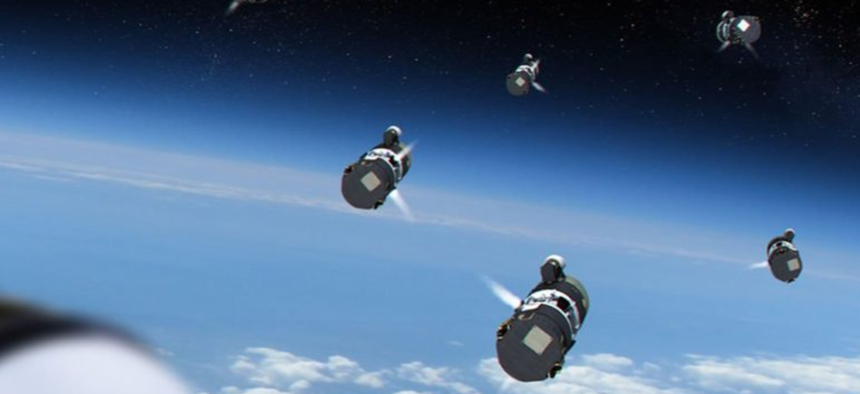
Artist's conception of the Multi-Object Kill Vehicle deploying to attack an incoming missile. Missile Defense Advocacy Alliance
Pentagon Accelerates Work on Multi-Warhead Interceptor
Officials won’t say it’s because of North Korea. But experts say Pyongyang’s planned ICBMs will almost certainly release decoys to cloak their nukes.
The Missile Defense Agency, or MDA, is accelerating the development of an interceptor that can take down several incoming warheads — or one warhead and several decoys — simultaneously. While MDA officials say the move is not a response to any specific threat, one prominent defense watcher notes that North Korea is likely working hard on missiles that can fire decoys to confuse interceptors.
The most recent Pentagon budget request seeks $259 million to move the Multi-Object Kill Vehicle, or MOKV, program into a new development phase — and speed up its projected completion by five years.
“We have accelerated MOKV risk reduction and product development phases to achieve a demonstrated capability in the 2025 timeframe,” said an MDA official in an email to Defense One.
MDA’s decision to accelerate the MKOV program is, in part, a vote of confidence in recent technological gains. On Tuesday, Boeing announced that MDA had awarded the company a $58 million, 35-month contract, to demonstrate their MOKV design.
“Our MOKV concept gives the Missile Defense Agency flexibility in eliminating threats more efficiently and affordably,” Paul Geery, a vice president of Boeing Phantom Works, said in a press release.
Related: Pick Up the Pace on Missile Defense
Related: Related: As Missile Defense Technology Improves, So Do Odds of an Arms Race in the Pacific
Related: The Dirty Secret of US-Israel Missile Defense Cooperation
The MDA official said the acceleration decision is “not in response to any specific intelligence, but to stay ahead of potential future threats.”
How far along is North Korea in developing a missile that can shoot decoys and more easily avoid interception? In March, Defense One put that question to Mitch Stevison, vice president of Raytheon Missile Systems.
“I’m really careful about talking about threats because those immediately go into areas that we can’t really talk about,” said Stevison. “I would characterize it like this: the pace that we see the potential adversaries testing should tell us something.”
David Wright, the co-director of the Union of Concerned Scientists’ Global Security Program, was a bit more forthcoming. “It’s very likely that [North Korea] is working on [missile interceptor] countermeasures of various kinds, including adding multiple decoys to its missiles, and this is something it should be able to do. Since the decoys are intended to work above the atmosphere (as is the kill vehicle) they can be very lightweight, so you avoid the problem of too much mass,” Wright said.
“Too much mass” is a key reason why North Korea has not yet been able to put a 650-plus-kilogram nuclear warhead atop an ICBM that could hit the United States.
In 2000, the Union pulled together a group of experts to assess next-generation missile countermeasures. Wright says that the basic conclusions of their report, including the likely use of decoys, still hold up.
“Our bottom line was that if a country has the technical ability and motivation to build a long-range missile and a nuclear warhead to go on it, it will also have the technical capability to add countermeasures to that missile that will be effective in defeating the defense, and it will have the motivation to add them to the missile,” he said. “It does not make sense to assume that countermeasures will be an afterthought. We expect North Korea would be developing them as an integral part of developing ballistic missiles in the age of missile defenses.”
MDA hopes to develop and test “command and control strategies in both digital and hardware,” in 2017, an agency official told Scout Warrior in February.




